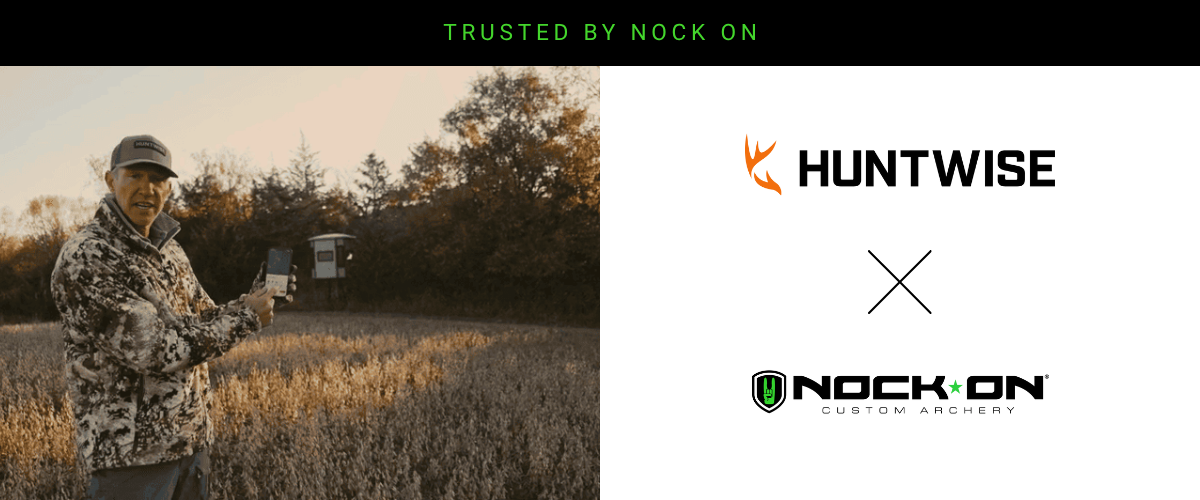Often, the best hunting spots aren’t found. They’re made.
After years of watching deer seek refuge in nearly impenetrable thickets, I decided it was time to turn a challenging piece of property into a tactical killing zone.
Today, I’ll walk you through how I turned 80 acres of overgrown cattle pasture into what I expect will be one of my most productive rut hunting spots this season.
TIP: Optimize your time this season with HuntWise! To get your Nock On Nation 25% discount visit: get.huntwise.com/nockon
Identifying the Problem and Opportunity
This property has everything a mature buck could want: security, isolation, and near-perfect cover.
Some of this 80-acre piece has row crop, but the majority is a thick, old cattle pasture that’s grown up over the last 20–30 years with invasive trees and brush. In many places, it’s too thick, almost unhuntable in its natural state.
During gun seasons over the years, I’ve watched countless deer, including some true giants, disappear into this jungle. The cover is so dense hunters can’t access it effectively.
This observation put this property on my radar. It wasn’t a question of whether big deer were using it, but how I could create a way to hunt them strategically. How do you turn impenetrable cover into huntable habitat without destroying what makes it attractive to deer?
The Strategic Setup
I hired a pulverizer machine to create travel corridors and hunting pockets within the thicket. This wasn’t random brush clearing. I carefully mapped out a system designed with specific deer behavior in mind.
First, I established perimeter paths around the property edges. These allow deer to comfortably move through the property with thick cover just 30 yards off the path.
The corridors connect transition areas, one leading to row crops and the other deeper into thick cover. I’ve created highways for deer that maintain their security and make their movement patterns more predictable.
The machine made quick work of the small-diameter trees and brush, pulverizing everything into natural mulch on the forest floor. These strategic movement lanes preserve the security cover that makes this property special.
Tactical Hunting Considerations
During the pre-rut and rut phases, does evacuate open fields and stick to thick cover to avoid harassment. Meanwhile, bucks put down rub lines, make scrapes, and cover ground in search of the first receptive does.
This is perfect for the notorious lockdown phase when a hot doe pulls multiple bucks into the thickest cover. Most hunters struggle during this phase because deer activity seems to disappear, but my new setup puts me right where the action happens.
When bucks first transition into daylight movement during the rut, they often stage in areas exactly like this. When other hunters see black blobs appear at the edges of crop fields at last light, I’ll be positioned where those bucks actually spend their daylight hours.
The Perfect Ambush Point
After walking the entire 80-acre property, I found only one or two trees suitable for a treestand.
This isn’t like hunting mature hardwoods where options abound. In this thick stuff, the entire operation hinges on identifying the right tree.
The tree I selected is highly advantageous:
- Perfect position overlooking the intersection of travel corridors
- Adequate height and structure for a safe, concealed stand
- Good cover to break up my outline
- Multiple approach options, including creek access for silent entry
The wind direction dictated the exact placement of the clearings. Using my hunting app, I plotted the entire setup to work with my most favorable wind patterns.
The primary wind will blow directly into my face as deer approach along the travel corridors. This is non-negotiable. Wind direction determines everything in a setup like this.
The clearing I created around my stand location is the perfect size for deploying a buck decoy during the rut. The open pocket creates an ideal theater for rattling sequences. When bucks hear fighting in thick cover, they move in quickly and quietly, often using the type of cleared travel lanes I created.
This setup anticipates a buck’s natural tendency to button hook downwind of any suspicious sound or sight. With my stand positioned correctly for the prevailing wind, bucks attempting this maneuver will walk right into my shooting lane at 15–20 yards.
Future Development Potential
This setup is primed for this season, but I’m thinking long-term, too. The clearing process has already allowed sunlight to reach the forest floor, and new growth is sprouting through the mulched ground.
Over the next couple of years, as the wood chips break down into rich compost, I’ll overseed these lanes with clover. This will turn the corridors into a one-stop shop for all deer’s needs.
The Complete Package
What excites me most about this setup is how it solves the classic hunting dilemma: Deer are often most vulnerable in places that are least huntable. By strategically modifying the habitat, I’ve created an accessible sanctuary that deer will still use.
I didn’t just clear brush and call it a day. I analyzed deer behavior, wind direction, tree stand options, and silent access routes before firing up the pulverizer. The result is a comprehensive system that should produce for years to come.
So, before you write off that thick section of your hunting property, consider how a strategic modification might turn it into your most productive spot.






 massmonopoly
massmonopoly